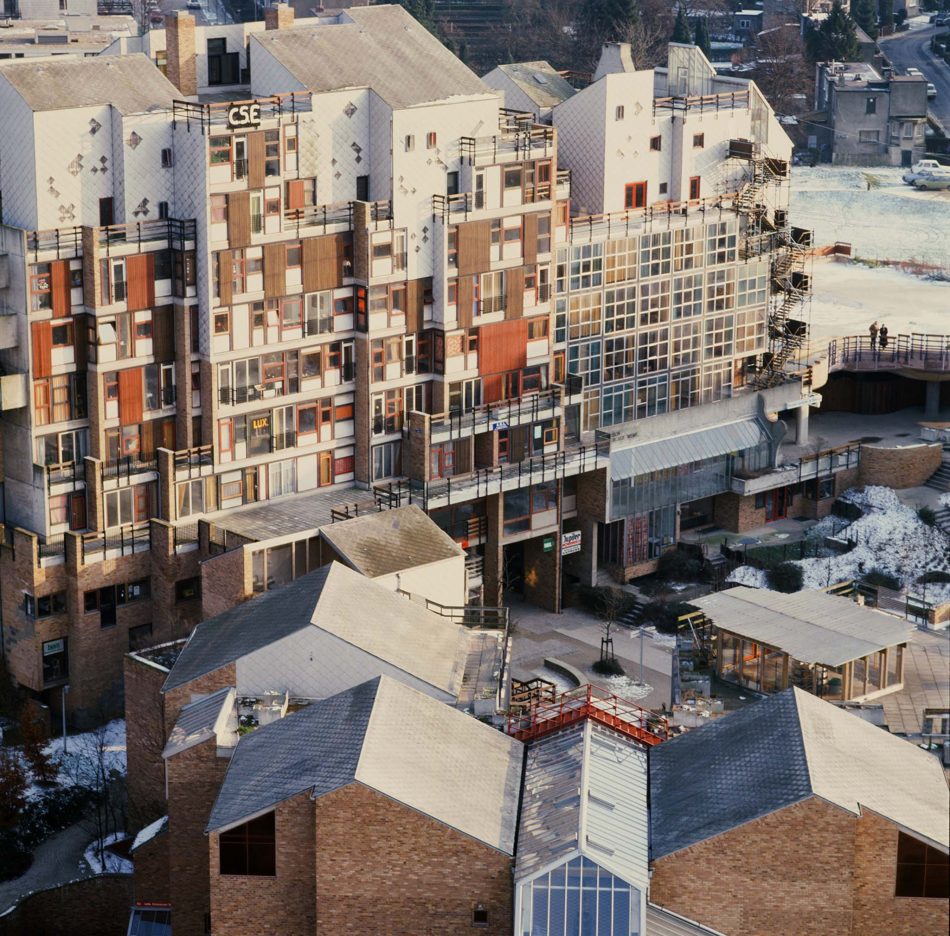这种对物质约束的解放并不是窗户所独有的,它涉及到整个建筑的组织。这些新环境使建筑先锋与抽象艺术运动如立体主义和纯粹主义联系起来。建造形式获得相对自治,今后三个功能——光、视线和空间衔接——可能是由不同的开口,精确地适应每个功能。一个开放的框架,一个选定的视角不再必须提供光(例如,路易斯卡恩和马里奥波塔等人的作品)。玻璃、钢铁和密封剂开辟了减少室内外分隔的新途径(例如,里特维尔德、密斯·凡德罗、菲利普·约翰逊等人的作品)。
This liberation from material constraints is not unique to the window; it involves the whole organization of the building. These new conditions made it possible for the architectural avant-garde to ally itself with such abstract art movements as Cubism and Purism. Built form having acquired relative autonomy with respect to the constraints traditionally imposed by the logic of construction, henceforth the three functions – light, view and spatial articulation – could be made by different openings, precisely and uncompromisingly adapted to each function. An opening framing a selected view no longer had to provide light, which could just as well be provided overhead (compare, for example, works by Louis Kahn and Mario Botta, among others). Glass, steel and sealants have opened new ways to reduce the separation between interior and exterior (see, for example, works by Gerritt Rietveld, Ludwig Mies van der Rohe, Phillip Johnson and others).
自由来自不易,它不仅带来了窗户的形式多样性,也带来了整个建筑作品的形式多样性。当每扇窗户或每座建筑都遵循自己的逻辑,不尊重其邻居或其前身,结果缩小了风景如画混乱之间的差距。虽然在古典建筑中,窗户本身可以被认为是一个美丽的物体(这也证明了单独分析这个单一元素是合理的),但美丽的现代窗户只能被理解为与整个空间布局有关。它本身已不再是一个客体。
This freedom is not won without tears; it has led to a great formal diversity of not only windows, but of the built work as a whole. When each window or each building follows its own logic, without respecting its neighbour or its predecessors, the result narrows the gap between the picturesque, on the one hand, and chaos on the other. Whilst in classical architecture the window could be considered a beautiful object in itself (which also justified separate analysis of this single element), the beautiful modern window can only be understood in relation to the whole spatial layout. It has ceased to be an object in itself.
在这样的背景下,成为一名建筑学的学生或教师要求更高。当它的门楣不再需要承受墙壁的重量时,垂直窗口的根基在哪里? 放眼望去,当代建筑的根基在哪里? 同时我们发现吕席安.克罗尔的窗户风景如画,随意安排;马里奥·博塔巨大开口聚集了不同类型的开窗法;阿尔多·罗西的强迫广场;约翰·海杜克和理查德·迈耶墙的部分溶解创造空间渗透;密斯·凡·德·罗的透明;表面的反光诺曼·福斯特;罗伯特·文丘里作品中含蓄地提到了传统的主题;在莱昂·克里尔和里卡多·博菲尔的作品中故意歪曲了过去的意象。
To be a student or a teacher of architecture within this context is more demanding; where are the certainties of the vertical window when its lintel no longer needs to carry the weight of the wall? And where are the certainties when, searching the horizon of contemporary building output, we find simultaneously the picturesque , haphazard arrangement of the windows of Lucien Kroll, the powerful wall openings of Mario Botta, which draw together different types of fenestration in one major element, the obsessional square of Aldo Rossi, the partial dissolution of the wall creating a play of spatial interpenetration in the case of John Hejduk and Richard Meier, the transparent façade of Ludwig Mies van der Rohe arid the reflective one of Norman Foster, the implicit reference to conventional motifs in the work of Robert Venturi and the deliberate distortion of imagery of the past in that of Leon Krier and Ricardo Bofill?

© Atelier Lucien Kroll
然而,这种多样性并不仅仅是新技术的结果。它首先与我们不再需要极端简单的物质财富有关,其次与我们社会的民主性有关,在这种民主性中,知识分子、国家和贪婪的银行都无权决定什么是适当的,什么是不适当的。
This diversity is not, however, only the result of new techniques. It is firstly linked to our material wealth which no longer requires extreme simplicity, and secondly to the democratic nature of our society in which neither the intelligentsia, nor the state, nor avaricious banks can claim the right to determine what is appropriate and what is not.
窗户大量的选择性只是当代建筑中固有的概念多元性的一个例子。今天的建筑师在寻找范例的过程中遇到了巨大的困难,面临着矛盾但共存的选择。“真理”是多重的、矛盾的、短暂的。建筑可以物化,建筑和城市设计只能在相对稳定的人类价值体系内进行,这些价值体系与活动和地点有关。考虑到在人类历史上,积累的知识从未如此丰富,个人也从未如此容易获得。档案已经建立起来,巨大的图书馆把它们的藏书电子化。建筑期刊提供最新的思考,研究和设计工作可以在尽可能广泛的范围进行。这种多元化的共同特征在于试图将建筑从经济、技术和琐碎的事务中解脱出来。我们的希望是把它重新投资到更有意义的人类生活中去。
The multitude of windows is only one example of the conceptual plurality inherent in contemporary architecture in general. Today’s architect in search of paradigms encounters great difficulties in the face of the overwhelming choice between opposing but co-existing directions. The ‘truths’ are multiple, contradictory and ephemeral. Construction can be objectivized; architecture and urban design can only be so within relatively stable systems of human values linked to activities and to places. Consider that in the history of mankind, accumulated knowledge has never been so abundant nor so accessible to individuals. Archives have been established and gigantic libraries computerize their holdings. Architectural journals instantaneously provide the broadest possible range of the latest thinking, research and design work. The common feature of this elitist plurality lies in the attempt to snatch architecture from purely economic, technological and frivolous preoccupations. Our hope is to reinvest it with more meaningful objects for human life.
什么目标?二十世纪的技术和社会的巨大变化所导致的方法的多样性和社会和审美价值的不稳定性构成了这本书的前提。它们也突出并形成了对我们日常环境中形式多样性的批判,当它开始显得混乱,并成为我们难以将住宅和城市组织成“场所”的原因。
What objectives? The ambiguities of the plurality of approaches and the instability of social and aesthetic values caused by the great technological and sociological changes of the twentieth century underlie the premises of this book. They also highlight and form a critique of diversity of form in our daily environment when it starts to appear chaotic and becomes the cause of our difficulty in organizing house and city into ‘a bunch of places’.
为了让自己如何以最合适的方式建造一个纯粹的窗户,这本书采取了两种方法:提出建筑形式和秩序的基本原则,特别是那些独立于风格和时期的原则;认为当代建筑的介入相对于现有的状态,是一个有意义的新片段的插入,而不是一个个人的艺术发明。
这些方法可能是唯一可以弥补由我们的社会和它的形象的变化的速度造成的迷失的影响。 这本书既没有提供“教条”,也没有具体的做法,它仍然寻求理解构成建筑本质的形式和空间的世界。
In order to teach ourselves how to think about how to build a mere window in the most appropriate way, this book takes two approaches: it presents fundamental principles of form and order in building, in particular those which are relatively independent of style and period; and it considers contemporary architectural intervention relative to the existing state of affairs, as an insertion of a meaningful new fragment rather than a personal artistic invention.
These approaches are perhaps the only ones that can compensate for the disorientating effect caused by the speed of change within our society and its images. If this book offers neither ‘religion’ nor recipe, it seeks nevertheless to understand the world of forms and spaces which constitute the very substance of architecture.

[…] 1.1 危机中的窗口 […]